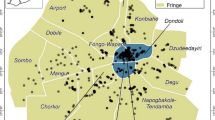k
-means nonhierarchical cluster analysis using farm size, slope, and distance to the nearest city center and highway as surrogates of farmland conversion. Discriminant analysis showed that the two groups derived from the cluster analysis were 98.8% accurate (P < 0.0000). Results from the statistical analysis may serve as a starting point for the identification of individual farms prone to residential development. To explain the driving forces of farmland conversion to residential uses, interviews should be conducted with farmers, landowners, and land buyers. The use of multivariate statistical techniques to identify farms in jeopardy of residential development, in conjunction with qualitative assessments that explain the probability of development of individual farms, may prove a useful strategy to understand and predict farmland conversion.
Similar content being viewed by others
Author information
Authors and Affiliations
Rights and permissions
About this article
Cite this article
Levia, Jr., D., Page, D. The Use of Cluster Analysis in Distinguishing Farmland Prone to Residential Development: A Case Study of Sterling, Massachusetts. Environmental Management 25, 541–548 (2000). https://doi.org/10.1007/s002679910042
Issue Date:
DOI: https://doi.org/10.1007/s002679910042




